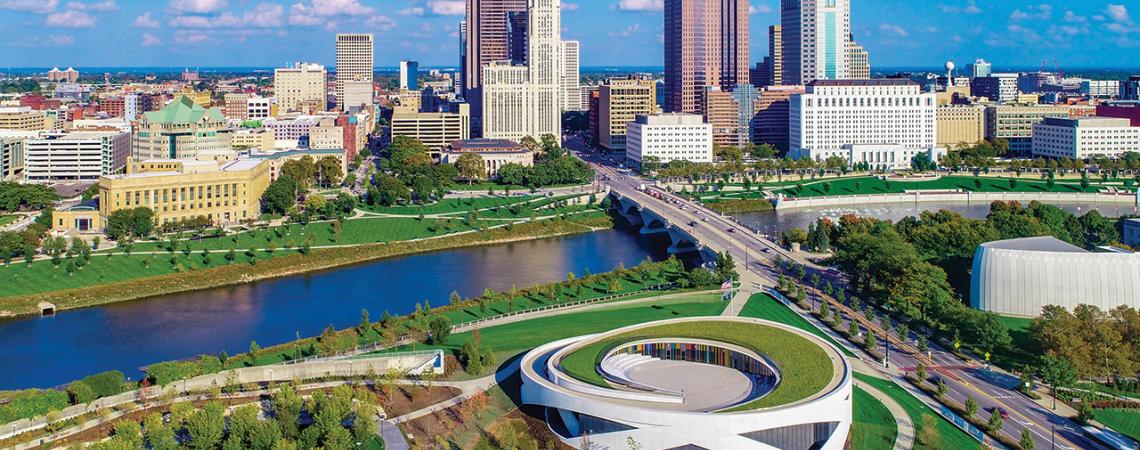The National Veterans Memorial and Museum in Columbus is a salute to service and sacrifice.
A Vietnam veteran was exploring the then newly opened National Veterans Memorial and Museum (NVMM) when he saw another man, a veteran of World War II, and stopped him in his tracks with a “Thank you for your service.”
“It was a very moving moment,” says Shelley Hoffman, associate director of external affairs, who witnessed the scene. The poignant episode epitomizes NVMM’s unique mission: saluting every veteran from every branch of the U.S. military in every period of war and peace.
Neither a solemn war memorial nor a static weapons museum, NVMM pays tribute to the 40 million men and women who have served in the nation’s armed forces by collecting, preserving, and sharing their personal stories. “Most military museums have tanks or planes,” Hoffman says. “We have voices.”
Indeed, storytelling is the museum’s defining element, and the voices that resonate throughout its exhibits are those of dozens of veterans representing different races, backgrounds, and types of military service. Visitors witness former Marine Corps Sgt. Jason Dominguez, whose Ohio-based Lima Company lost 23 members in Iraq, talk about visiting a fallen comrade’s grave. They hear Spc. 4 John Flinn, an Army dog handler and Purple Heart recipient, recall the hostility he encountered after returning from Vietnam. They listen to the tug-at-your-heart words of Chris Moe, wife of Air Force pilot and prisoner of war Thomas Moe, describing their reunion after his torturous years in the Hanoi Hilton.
Located along the Scioto River in downtown Columbus, NVMM was the brainchild of the late John Glenn, who, before he was a United States senator from Ohio and before he was an astronaut, was a Marine Corps aviator. “It was Senator Glenn’s vision to create a museum that was not specific to a particular conflict or branch of service,” Hoffman says. After President Trump signed a congressional act into law on June 21, 2018, it officially became the first and only national veterans’ museum.
The Columbus Downtown Development Corporation oversaw NVMM’s construction and utilized more than $80 million of private and public funding for a 53,000-square-foot museum building and an adjacent memorial grove. Designed by Allied Works Architecture of New York, the circular building consists of exterior bands of concrete that evoke the strength of the nation’s armed forces and culminate in a rooftop sanctuary with splendid views of the Columbus skyline. For the memorial grove, landscape architects from the OLIN design firm planned a 2.5-acre greenspace for remembrance and reflection.
Visitors enter through the Great Hall, a soaring space with enormous windows and wall-mounted gold letters that spell out NVMM’s purpose: Honor, Connect, Inspire, Educate. “Senator Glenn came up with those objectives, and they’re the pillars of the museum,” says Hoffman. Suspended from the Great Hall’s ceiling are giant photographs showing veterans as they look today, as well as when they were in uniform. Those powerful images that greet visitors make a statement about why NVMM strives to honor veterans’ contributions, connect civilians to the nation’s 20 million living veterans, and inspire and educate people about the value of service.
NVMM’s permanent exhibits take visitors on a double journey through a gallery flanked on one side by a timeline of U.S. military history and on the other by themed alcoves that highlight common veterans’ experiences — including “Leaving Home” and “Oath of Office” — and relate individual stories via audio and video recordings. Along the way are personal memorabilia and photos, boot camp hats and backpacks that folks can try on, and footlockers that open to tell firsthand tales of leaving family and friends. A multiscreen installation in the “Our Jobs” alcove depicts the array of tasks performed aboard the Navy supercarrier George H.W. Bush, while an interactive “Where We Were” display lets visitors summon historical statistics about U.S. deployments.
In the Remembrance Gallery, colorfully striped windows mimic the campaign ribbons military personnel wear as badges of honor, but the focal point is a folded American flag surrounded by mirrors that give the illusion of infinite stars and stripes. Having been flown over the Tomb of the Unknown Soldier in Arlington National Cemetery, that flag represents the more than 2 million military members who lost their lives in service. Among them was Army Captain Leo Allen Bauer, and NVMM’s “Why We Serve” exhibit now showcases a 1964 letter he sent from Vietnam to his young daughters.
“Today I am part of the force that is fighting to preserve the United States and its freedoms for you and your children to enjoy just as Mother and I have, along with our parents and grandparents,” wrote Bauer. “I am here for many reasons — perhaps the biggest is love — love for my family, you two girls and your Mother; and for our country and its way of life.”
Ten months later, Bauer was killed in action, and his voice went silent forever.









